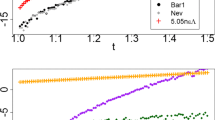Abstract
Diagonally implicit Runge-Kutta methods are examined. It is shown that, for stiff problems, the methods based on the minimization of certain error functions have advantages over other methods; these functions are determined in terms of the errors for simplest model equations. Methods of orders three, four, five, and six are considered.
Similar content being viewed by others
References
E. Hairer and G. Wanner, Solving Ordinary Differential Equations, Vol. 2: Stiff and Differential-Algebraic Problems (Springer, Berlin, 1987–1991; Mir, Moscow, 1999).
R. Alexander, “Diagonally Implicit Runge-Kutta Methods for Stiff O.D.E.’s,” SIAM J. Numer. Anal. 14, 1006–1021 (1977).
F. Cameron, M. Palmroth, and R. Piche, “Quasi Stage Order Conditions for SDIRK Methods,” Appl. Numer. Math. 42, 61–75 (2002).
M. E. Hosea and L. F. Shampine, “Analysis and Implementations of TR-BDF2,” Appl. Numer. Math. 20, 21–37 (1996).
F. Cameron, “A Class of Low Order DIRK Methods for a Class of DAE,” Appl. Numer. Math. 31, 1–16 (1999).
J. C. Butcher and D. J. L. Chen, “A New Type of Singly-Implicit Runge-Kutta Methods,” Appl. Numer. Math. 34, 179–188 (2000).
R. Williams, K. Burrage, I. Cameron, and M. Kerr, “A Four-Stage Index 2 Diagonally Implicit Runge-Kutta Method,” Appl. Numer. Math. 40, 415–432 (2002).
L. M. Skvortsov, “Diagonally Implicit FSAL Runge-Kutta Methods for Stiff Differential Algebraic Systems,” Matem. Modelir. 14(2), 3–17 (2002).
L. M. Skvortsov, “Accuracy of Runge-Kutta Methods Applied to Stiff Problems,” Zh. Vychisl. Mat. Mat. Fiz. 43, 1374–1384 (2003) [Comput. Math. Math. Phys. 43, 1320–1330 (2003)].
R. Alexander, “Design and Implementation of DIRK Integrators for Stiff Systems,” Appl. Numer. Math. 46, 1–17 (2003).
C. A. Kennedy and M. H. Carpenter, “Additive Runge-Kutta Schemes for Convection-Diffusion-Reaction Equations,” Appl. Numer. Math. 44, 139–181 (2003).
M. R. Kristensen, J. B. Jorgensen, P. G. Thomsen, and S. B. Jorgensen, “An ESDIRK Method with Sensitivity Analysis Capabilities,” Comput. Chem. Eng. 28, 2695–2707 (2004).
A. Kvärnö, “Singly Diagonally Implicit Runge-Kutta Methods with an Explicit First Stage,” BIT 44, 489–502 (2004).
K. Dekker and J. G. Verver, Stability of Runge-Kutta Methods for Stiff Nonlinear Differential Equations (North-Holland, Amsterdam, 1984; Mir, Moscow, 1988).
L. M. Skvortsov, “Explicit Runge-Kutta Methods for Moderately Stiff Problems,” Zh. Vychisl. Mat. Mat. Fiz. 45, 2017–2030 (2005) [Comput. Math. Math. Phys. 45, 1339–1351 (2005)].
D. S. Guzhev and N. N. Kalitkin, “An Optimal Scheme for the Package ROS4,” Mat. Modelir. 6(11), 128–138 (1994).
K. A. Kochetkov and P. D. Shirkov, “L-Decremented ROW Methods of the Third Order of Accuracy,” Zh. Vychisl. Mat. Mat. Fiz. 37, 699–710 (1997) [Comput. Math. Math. Phys. 37, 680–690 (1997)].
N. V. Shirobokov, “Diagonally Implicit Runge-Kutta Methods,” Zh. Vychisl. Mat. Mat. Fiz. 42, 1013–1018 (2002) [Comput. Math. Math. Phys. 42, 974–979 (2002)].
E. Hairer, S. Nørsett, and G. Wanner, Solving Ordinary Differential Equations, Vol. 1: Nonstiff Problems (Springer, Berlin, 1987–1991; Mir, Moscow, 1990).
O. S. Kozlov, D. E. Kondakov, L. M. Skvortsov, et al., “The Software Package ’simulation in Egineering Devices,’” http://model.exponenta.ru/mvtu/20050615.html.
O. S. Kozlov, L. M. Skvortsov, and V. V. Khodakovskii, “Solving Differential and Differential Algebraic Equations Using the MVTU Software Package,” http://model.exponenta.ru/mvtu/20051121.html.
Test Set for Initial Value Problem Solvers: Release 2.2, August 2003 http://www.dm.uniba.it.:_testset.
Author information
Authors and Affiliations
Additional information
Original Russian Text © L.M. Skvortsov, 2006, published in Zhurnal Vychislitel’noi Matematiki i Matematicheskoi Fiziki, 2006, Vol. 46, No. 12, pp. 2209–2222.
Rights and permissions
About this article
Cite this article
Skvortsov, L.M. Diagonally implicit Runge-Kutta methods for stiff problems. Comput. Math. and Math. Phys. 46, 2110–2123 (2006). https://doi.org/10.1134/S0965542506120098
Received:
Accepted:
Issue Date:
DOI: https://doi.org/10.1134/S0965542506120098




